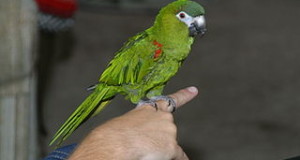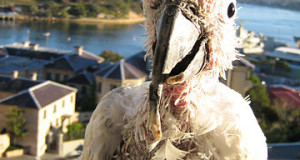Canaries (Serinus canarius) have been captive bred for hundreds of years and in that time have come to thrive upon the rather simple seed-based diets that many owners provide to them. However, for optimum health, vibrant color, enhanced singing abilities and successful reproduction, your birds will require additional dietary variety. Today I’d like to highlight some often over-looked Canary foods. The diet described here is also suitable for the Canary’s close relative, the Green Singing Finch (C. mozambicus).
Note: Please introduce all new foods slowly and in small amounts, to avoid digestive upset.
General Considerations
 In addition to providing optimal nutrition, the diet fed to your birds should encourage activity and interest. Wild birds spend most of their day foraging – a captive that meets its feeding requirements in few minutes quickly becomes bored and listless. Always strive for ways to keep your Canary occupied with food-gathering – live insects, pieces of whole fruit, sprouting greens and millet sprays are just a few items that will encourage active foraging and a pert, alert pet.
In addition to providing optimal nutrition, the diet fed to your birds should encourage activity and interest. Wild birds spend most of their day foraging – a captive that meets its feeding requirements in few minutes quickly becomes bored and listless. Always strive for ways to keep your Canary occupied with food-gathering – live insects, pieces of whole fruit, sprouting greens and millet sprays are just a few items that will encourage active foraging and a pert, alert pet.
The Basic Diet
A seed mix containing millet, canary and rape seed, along with others in smaller quantities, should comprise the bulk of your bird’s diet. I prefer mixes which also include freeze-dried fruits and vegetables, such as Kaytee Fiesta Food and Higgins Vita-Canary Food.
Pelleted foods, which supply near-complete nutrition in a single pellet, should also be introduced. Many Canaries reject these at first – flavored products, such as ZU-Preem Fruit Blend, are your best options.
The bright colors of normal and red-factor Canaries can be kept at their best by adding a color-enhancing food, such as KayTee Exact Rainbow to the diet.
Greens, Fruit and Sprouts
Small amounts of plant-based foods should be offered on most days. New sprouts, one of the most healthful foods for Canaries and other finches, can be easily supplied with the Sprout Pot (this item is fun for children to use, as they get to grow their own sprouts). Endive, dandelion, escarole, apple, mango, grapes and other produce should also be offered several times each week.
Protein-Based Foods
Protein-rich food items are especially important before and during the breeding season, but should be offered to all Canaries throughout the year.
Small live waxworms, crickets, mealworms and other insects are especially relished, although some Canaries take time to “recognize” them (too long a captive history, perhaps!). Canned Insects and Freeze-Dried Flies, marketed for pet reptiles, are excellent (if less exciting for your bird!) alternatives.
Egg Food is perhaps the easiest way to provide your Canary with protein, and is well-accepted by most individuals.
Treats
Treats, especially those that provide novel foods and a challenge to the bird, are an excellent addition to Canary diets. Please check out our Canary Treat Pack and extensive line of Bird Treats for ideas.
Supplements
Grit and Cuttlebone should always be available.
A high quality Vitamin Supplement may be useful, but check with your veterinarian first – Canaries that are consuming a well-balanced diet may not need additional vitamins.
Further Reading
The Canary’s captive history holds many surprises – please see my article Shipwrecks, Vicious Dogs and Escaped Birds for details.
The Canary Handbook is an excellent source of information for new and experienced Canary owners.
This Video of a singing Canary shows why they remain among the most popular of all pet birds.
 That Bird Blog – Bird Care and History for Pet Birds
That Bird Blog – Bird Care and History for Pet Birds




One comment
Pingback: Canaries diet | Kenskeysandloc